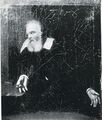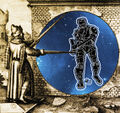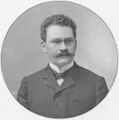Template:Selected anniversaries/June 22: Difference between revisions
No edit summary |
No edit summary |
||
| Line 1: | Line 1: | ||
<gallery> | <gallery> | ||
||1429 | ||1429: Jamshīd al-Kāshī dies ... astronomer and mathematician. No pic, no birth date. | ||
File:Galileo E pur si muove.jpg|link=Galileo Galilei (nonfiction)|1633: The Holy Office in Rome forces [[Galileo Galilei (nonfiction)|Galileo Galilei]] to recant his view that the Sun, not the Earth, is the center of the Universe in the form he presented it in, after heated controversy. | File:Galileo E pur si muove.jpg|link=Galileo Galilei (nonfiction)|1633: The Holy Office in Rome forces [[Galileo Galilei (nonfiction)|Galileo Galilei]] to recant his view that the Sun, not the Earth, is the center of the Universe in the form he presented it in, after heated controversy. | ||
| Line 6: | Line 6: | ||
File:Anarchimedes measuring Galileo.jpg|link=Anarchimedes|1633: Rogue mathematician and alleged supervillain taunts [[Galileo Galilei (nonfiction)|Galileo Galilei]] for recanting, daring Galileo to "tell it like it is, and let them burn you for it." | File:Anarchimedes measuring Galileo.jpg|link=Anarchimedes|1633: Rogue mathematician and alleged supervillain taunts [[Galileo Galilei (nonfiction)|Galileo Galilei]] for recanting, daring Galileo to "tell it like it is, and let them burn you for it." | ||
||1792 | ||1792: James Beaumont Neilson born ... engineer and businessman. | ||
File:Mark Twain by Abdullah Frères, 1867.jpg|link=Mark Twain (nonfiction)|1863: [[Mark Twain (nonfiction)|Mark Twain]] reports that adventurer and alleged "Pirate of the Prairies" [[Wallace War-Heels]] "is preparing to rescue Galileo, or so he says. Impossible, I know, irrational, madness itself; yet I have seen him appear from thin air on a flying horse, and I have heard his strange discourse at some length, and though he is more a man than an angel, I believe he must partake of both." | File:Mark Twain by Abdullah Frères, 1867.jpg|link=Mark Twain (nonfiction)|1863: [[Mark Twain (nonfiction)|Mark Twain]] reports that adventurer and alleged "Pirate of the Prairies" [[Wallace War-Heels]] "is preparing to rescue Galileo, or so he says. Impossible, I know, irrational, madness itself; yet I have seen him appear from thin air on a flying horse, and I have heard his strange discourse at some length, and though he is more a man than an angel, I believe he must partake of both." | ||
||1837 | ||1837: Paul Morphy born ... chess player. | ||
||Paul Gustav Heinrich Bachmann | ||1837: Paul Gustav Heinrich Bachmann born ... mathematician. His major works include ''Analytische Zahlentheorie'', a work on analytic number theory in which Big O notation was first introduced. | ||
||Mario Pieri | ||1860: Mario Pieri born ... mathematician who is known for his work on foundations of geometry. | ||
File:Hermann Minkowski.jpg|link=Hermann Minkowski (nonfiction)|1864: Mathematician and academic [[Hermann Minkowski (nonfiction)|Hermann Minkowski]] born. He will show that Albert Einstein's special theory of relativity can be understood geometrically as a theory of four-dimensional space–time, since known as the "Minkowski spacetime". | File:Hermann Minkowski.jpg|link=Hermann Minkowski (nonfiction)|1864: Mathematician and academic [[Hermann Minkowski (nonfiction)|Hermann Minkowski]] born. He will show that Albert Einstein's special theory of relativity can be understood geometrically as a theory of four-dimensional space–time, since known as the "Minkowski spacetime". | ||
| Line 48: | Line 48: | ||
||Reinhold Remmert (b. 22 June 1930) was a German mathematician. Born in Osnabrück, Lower Saxony, he studied mathematics, mathematical logic and physics in Münster. He established and developed the theory of complex-analytic spaces in joint work with Hans Grauert. Pic. | ||Reinhold Remmert (b. 22 June 1930) was a German mathematician. Born in Osnabrück, Lower Saxony, he studied mathematics, mathematical logic and physics in Münster. He established and developed the theory of complex-analytic spaces in joint work with Hans Grauert. Pic. | ||
||1936 | ||1936: Moritz Schlick dies ... physicist and philosopher. | ||
||1940: Daniel Quillen born ... mathematician. He is known for being the "prime architect" of higher algebraic K-theory, for which he was awarded the Cole Prize in 1975 and the Fields Medal in 1978. Pic: https://ronsview.org/2011/05/10/daniel-quillen/ | |||
File:Vandal Savage Field Report Peenemunde.jpg|link=Field Report Number One (Peenemunde)|1943: ''[[Field Report Number One (Peenemunde)|Field Report Number One (Peenemunde edition)]]'' reveals Nazi efforts to rewrite history by false accusing [[Galileo Galilei (nonfiction)|Galileo Galilei]] of committing [[crimes against mathematical constants]]. | File:Vandal Savage Field Report Peenemunde.jpg|link=Field Report Number One (Peenemunde)|1943: ''[[Field Report Number One (Peenemunde)|Field Report Number One (Peenemunde edition)]]'' reveals Nazi efforts to rewrite history by false accusing [[Galileo Galilei (nonfiction)|Galileo Galilei]] of committing [[crimes against mathematical constants]]. | ||
||1953 | ||1953: Mauro Francaviglia born ... mathematician and academic. | ||
||Karl Taylor Compton | ||1954: Karl Taylor Compton dies ... physicist and president of the Massachusetts Institute of Technology (MIT) from 1930 to 1948. | ||
File:Gabriel Sudan 1932.jpg|link=Gabriel Sudan (nonfiction)|1977: Mathematician [[Gabriel Sudan (nonfiction)|Gabriel Sudan]] dies. He discovered the Sudan function, an important example in the theory of computation, similar to the Ackermann function. | File:Gabriel Sudan 1932.jpg|link=Gabriel Sudan (nonfiction)|1977: Mathematician [[Gabriel Sudan (nonfiction)|Gabriel Sudan]] dies. He discovered the Sudan function, an important example in the theory of computation, similar to the Ackermann function. | ||
||Harold Calvin Marston Morse | ||1977: Harold Calvin Marston Morse dies ... mathematician best known for his work on the calculus of variations in the large, a subject where he introduced the technique of differential topology now known as Morse theory. | ||
||1978 | ||1978: Charon, Pluto's first satellite, was discovered at the United States Naval Observatory by James W. Christy. | ||
||1990 | ||1990: Ilya Frank dies ... physicist and academic, Nobel Prize laureate. | ||
||2004 | ||2004: Bob Bemer dies ... computer scientist and engineer. | ||
||Thomas Gold | ||2004: Thomas Gold dies ... astrophysicist. | ||
</gallery> | </gallery> | ||
Revision as of 08:23, 4 October 2018
1633: The Holy Office in Rome forces Galileo Galilei to recant his view that the Sun, not the Earth, is the center of the Universe in the form he presented it in, after heated controversy.
1633: Rogue mathematician and alleged supervillain taunts Galileo Galilei for recanting, daring Galileo to "tell it like it is, and let them burn you for it."
1863: Mark Twain reports that adventurer and alleged "Pirate of the Prairies" Wallace War-Heels "is preparing to rescue Galileo, or so he says. Impossible, I know, irrational, madness itself; yet I have seen him appear from thin air on a flying horse, and I have heard his strange discourse at some length, and though he is more a man than an angel, I believe he must partake of both."
1864: Mathematician and academic Hermann Minkowski born. He will show that Albert Einstein's special theory of relativity can be understood geometrically as a theory of four-dimensional space–time, since known as the "Minkowski spacetime".
1865: Adventurer and alleged "Pirate of the Prairie" Wallace War-Heels tells reporters that he has sworn to rescue Galileo Galilei, who has been false accused of committing crimes against mathematical constants.
1910: Engineer, inventor, and pioneering computer scientist Konrad Zuse born. He will invent the Z3, the world's first working programmable, fully automatic computer.
1943: Field Report Number One (Peenemunde edition) reveals Nazi efforts to rewrite history by false accusing Galileo Galilei of committing crimes against mathematical constants.
1977: Mathematician Gabriel Sudan dies. He discovered the Sudan function, an important example in the theory of computation, similar to the Ackermann function.







